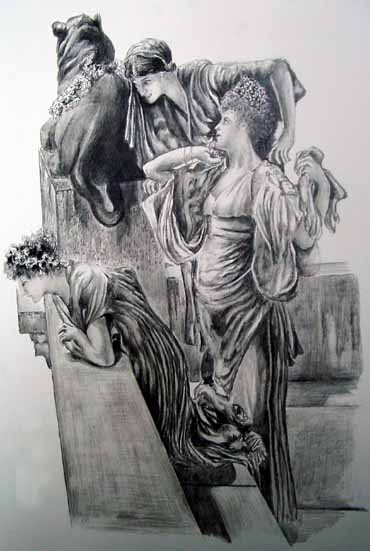- Paul Sandilands
- View Portfolio
- Image 172 of 204
- Added 14 Sep 2004
- 440 Views
- 8 Comments
- Share This Image On...

Lawrence Alma Tadema (born Laurens Tadema) was Dutch, and only came to England when in his mid-30s, in 1869. He was a great Anglophile, and became very much part of the English establishment, becoming ARA in 1876, RA in 1879 and gaining a knighthood in 1899. Early influences on his art included George Ebers, a famous Egyptologist, and he painted some ancient Egyption scenes, most notably Pastimes in Ancient Egypt in 1864. However, after a visit to Pompeii, he painted above all the life of ancient Greece and Rome, concentrating on the domestic and the homely rather than the dramatic. His paintings were commissioned en masse by the art dealer Ernest Gambart, who encouraged him to concentrate on the highly saleable classical paintings. In London, after the death of his first wife, Alma Tadema married Laura Epps, who appears in many of his pictures (along with his daughters later on), with curly red or brown hair, rosy cheeks, and solid rather than fine-boned features. Another characteristic Alma Tadema feature is marble, and he is the supreme painter of that material. His pictures are full of accurate archaelogical detail, praised highly by Ruskin, although the famous critic had good and bad things to say about Alma Tadema. The ambitious Spring (1895), with a procession of dozens of children and women bearing flowers and musical instruments, overlooked by marble buildings and spectators tossing more flowers, was described by the Magazine of Art as "a wonderful picture of colour, figures, movement, blue sky, marble, a hundred beautiful accessories exquisitely painted... he has improved on the splendour of the buildings as he has improved on the demeanour of the populace... there is here no hint of 'excessive merriment, drinking and lascivious games'; all is perfectly respectable, gorgeous and exquisitely beautiful." His paintings were without complicated themes or moral lessons and they were criticised for being lacking in any spirituality, and later for showing 'Victorians dressed up in ancient costume' (poor Laura Tadema, his frequent model, was said to be 'too fat in the ankles'). During his lifetime, Alma Tadema's work was very popular with the public, but his reputation declined rapidly after his death. Alma Tadema's pictures include Phidias and the Parthenon, notable for showing the marbles as being coloured, The Picture Gallery, which includes a portrait of the art-dealer Gambart, The Sculptor's Model, a nude undisguised as a goddess that caused some debate when it was exhibited (it was actually inspired by a recently discovered classical sculpture, the Esquiline Venus, and was painted as an object lesson to his pupil, The Hon. John Collier), The Roses of Heliogabalus, A Dedication to Bacchus, A Favourite Custom, one of many pictures on the topic of the Roman baths, and several pictures showing very blue sea in the distance behind exquisite marble, of which Silver Favourites is a good example. Alma Tadema is the archetypical Classicist painter, and at his peak rivalled Leighton in reputation. He was buried in the crypt of St Paul's Cathedral, where Leighton, Millais and Holman Hunt also lie. Alma Tadema had many followers and imitators, the best of them such as John William Waterhouse, John Collier and the American Elihu Vedder developing the classical themes in their own way. John William Godward devoted himself to the simple concept of the classically-robed girl standing on a marble terrace. Lesser followers include Henry Ryland, who made his name in watercolours and illustration, Arthur Hill, T. R. Spence, and to some extent Herbert Schmalz. Due to his extreme fashionability over a long period, many art galleries have a representative work by Alma Tadema. Phidias and the Parthenon is at Birmingham, Silver Favourites is at the Tate Gallery, In the Tepidarium is in the Lady Lever Gallery, The Art Lover in Glasgow, and smaller works are at Brighton and in the Ashmolean Museum, Oxford. Unconcious Rivals is at Bristol. Reading from Homer is at the Philadelphia Museum of Art, and the Walters Art Museum has his Sappho. An example of his style before he turned exclusively to Classical subjects is The Visit in the V & A.
5 of 8 Comments Show All 8 Comments
Herb Roe 02 Apr 2005
Beautiful pencil rendering of one of the least known masters of art, very nice.Ggi-Ghi Reynolds 18 Oct 2004
Extremely artistic, very dreamy to me. Pat on the back for this one !Hilton Harris 26 Sep 2004
Beautiful piece.Renata Cavanaugh 15 Sep 2004
Nicely donesher richardson 15 Sep 2004
wonderful historic feel Paul... you handle the pencil with lovely line work...